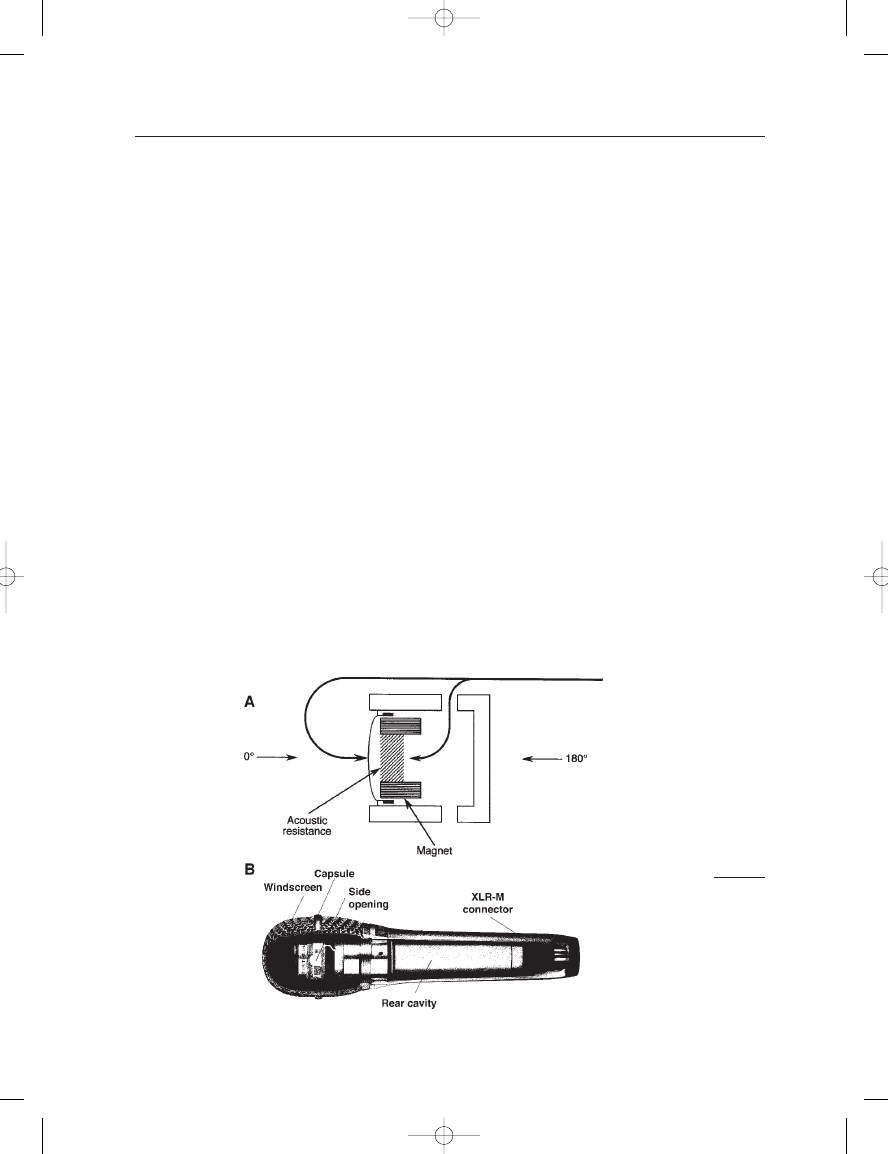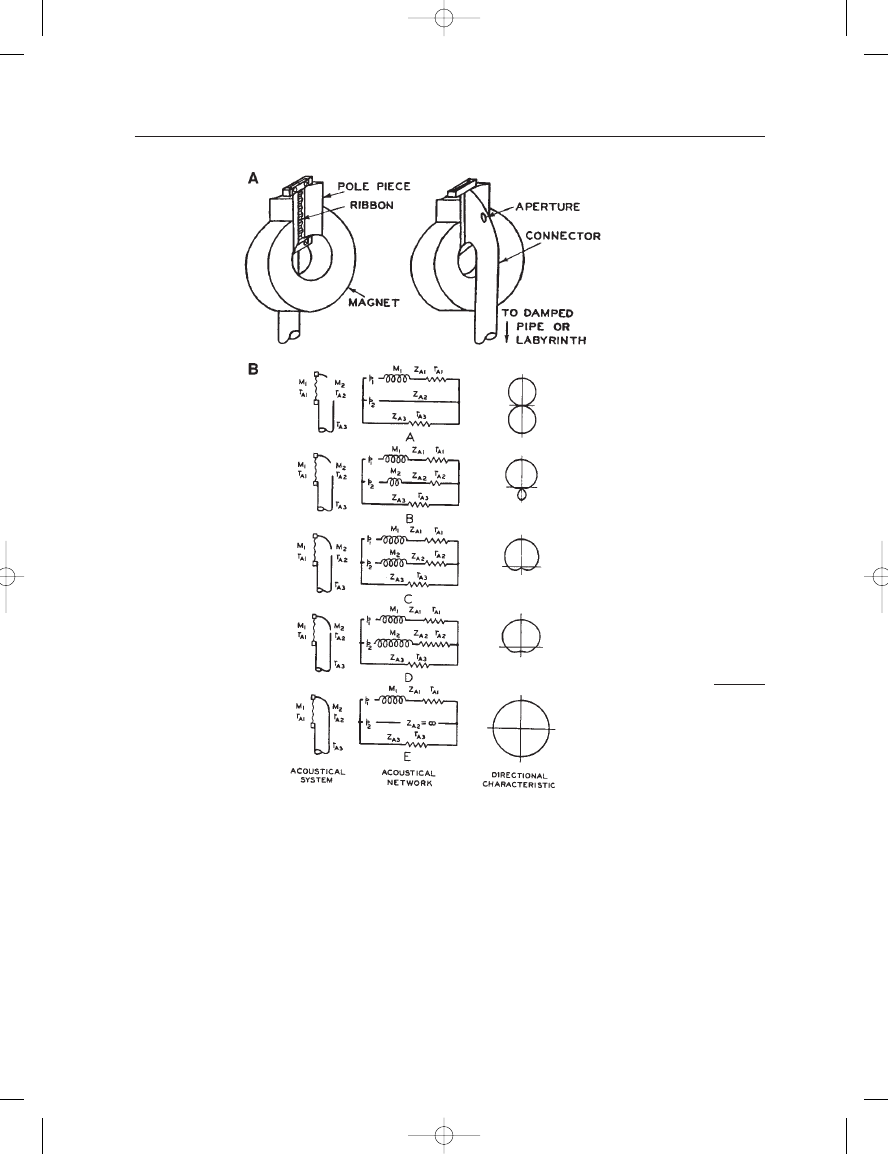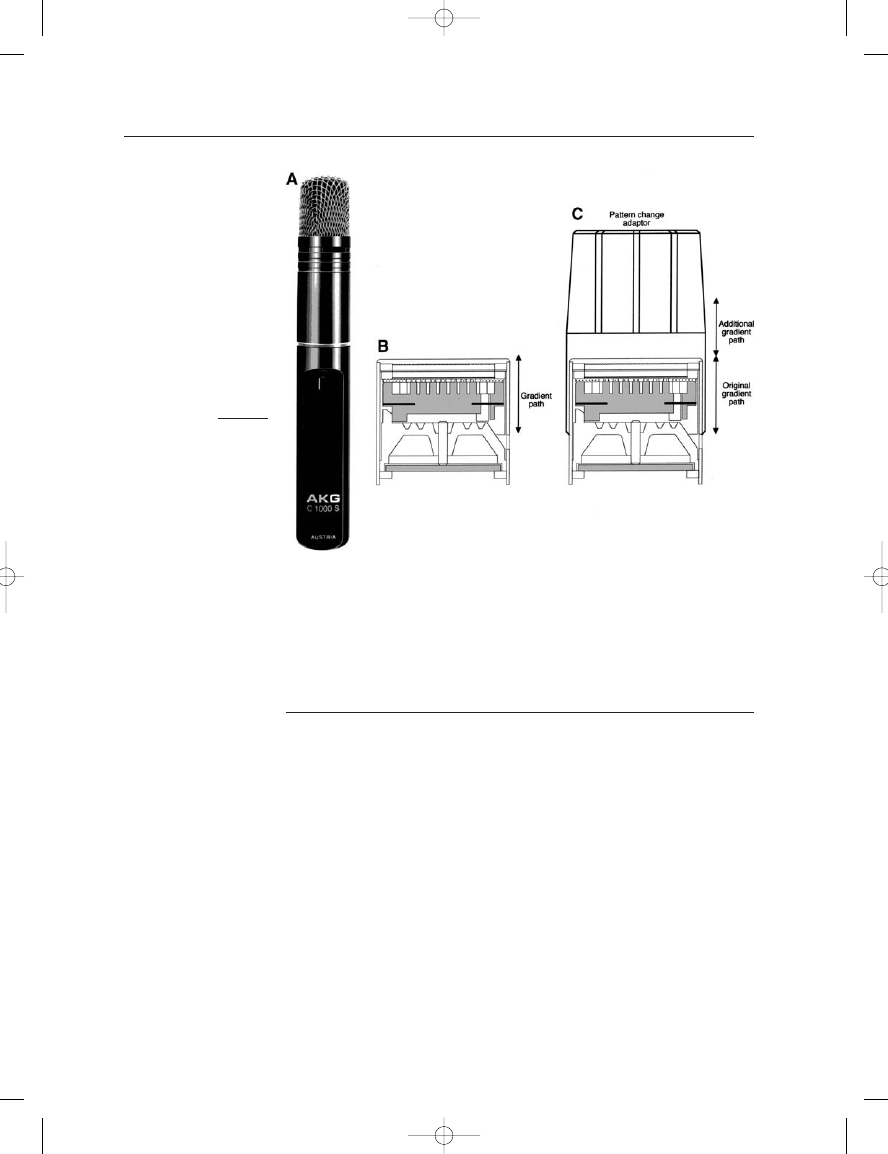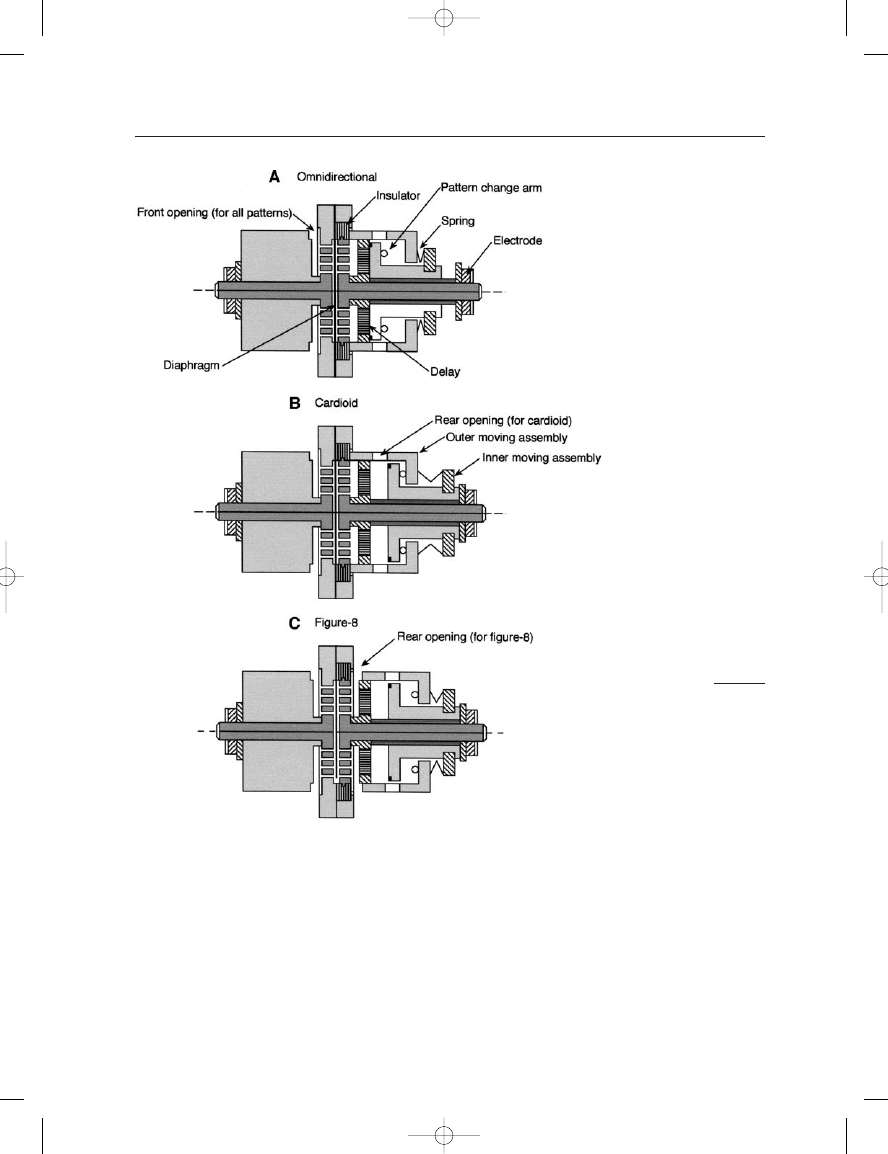ВУЗ: Казахская Национальная Академия Искусств им. Т. Жургенова
Категория: Книга
Дисциплина: Не указана
Добавлен: 03.02.2019
Просмотров: 17264
Скачиваний: 51

THE MICROPHONE BOOK
78
the microphone case that provides a delay path from the outside to the
back of the diaphragm. The net pressure gradient on the diaphragm is
the combination of the variable external delay, which is dependent on the
angle of sound incidence, and the fixed internal delay. The external
acoustical delay and the internal delay have been designed to be equal for
on-axis operation.
At 0
, the external acoustical delay and fixed internal delay add to pro-
duce a fairly large pressure gradient. This gradient increases with frequency,
as we noted in the preceding chapter, and the effect on a resistance-
controlled capacitor diaphragm is a constant output over the frequency
range. At 90
, the external delay is zero since sound arrives at the front
and rear openings of the microphone in-phase. Only the internal delay
contributes to the gradient and will be one-half the total delay for 0
. For
sound arriving along the 180
axis, the internal and external delays will
be equal but in phase opposition, producing a zero gradient and no signal
output from the microphone. A cutaway view of a single diaphragm
cardioid capacitor microphone is shown at C.
A similar approach can be taken with the dynamic microphone
(Bauer, 1941), as shown in Figure 5–14. This basic design is shown at A.
With numerous refinements and additions, it has become the basis for
today’s dynamic “vocal microphones” widely used throughout the music
and communication industries. For flat LF response the diaphragm must
be mass controlled. This may result in problems of LF handling noise
and overload, and most directional dynamic microphones are designed
with substantial LF damping, relying on proximity effect at close working
distances to equalize the effective frequency response.
FIGURE 5–14
Basic principle of a single
diaphragm dynamic
cardioid microphone (A);
cutaway view of a typical
dynamic single diaphragm
cardioid microphone (B).
(Photo courtesy of
Audio-Technica US.)
Earg_05.qxd 14/9/04 2:40 PM Page 78

5: First-Order Directional Microphones
79
As we have seen, the single diaphragm cardioid microphone has
much in common with the gradient microphone discussed in the previous
chapter. It is in fact a gradient microphone with the addition of a fixed
internal delay path behind the diaphragm. Changing the amount of inter-
nal delay enables the designer to produce other cardioid types. For exam-
ple, by shortening the delay appropriately a supercardioid pattern, with
its characteristic null at
126, and a hypercardioid pattern, with its
characteristic null at
110, can be attained. A cutaway view of a
typical single diaphragm dynamic cardioid microphone is shown at B.
VARIABLE PATTERN SINGLE DIAPHRAGM
MICROPHONES
By providing a means for physically changing the internal delay path,
variable pattern single diaphragm microphones can be realized. In gen-
eral, a microphone that offers a selection of patterns forces a trade-off in
terms of HF response and pattern integrity as compared with a micro-
phone that has been optimized for a single pickup pattern.
Olson (1957) describes an RCA ribbon microphone in the 77-series
that offered a number of pickup patterns. The basic design is shown in
Figure 5–15A. A cowl was placed behind the ribbon, and an aperture at
the back of the cowl could be varied by a shutter to produce the family
of first-order patterns, as shown at B.
The AKG Model C-1000 capacitor microphone is normally operated
with a cardioid pattern; however, the grille that encloses the capsule can
be removed by the user, and an adapter slipped over the capsule assembly
that effectively alters path lengths around the microphone to produce a
hypercardioid pattern. This design is shown in Figure 5–16. An external
view of the microphone is shown at A; the normal internal configuration
is shown at B, and the modified configuration at C.
When the pattern change adapter is placed over the microphone, an
additional distributed gradient path is provided. Since it is applied to the
positive side of the diaphragm, it works to some degree in opposition to
the built-in gradient path on the negative side of the diaphragm. In so
doing, it increases the dipole, or figure-8, contribution to the micro-
phone’s effective pattern thus producing a hypercardioid pattern.
A very elegant example of a variable pattern, single diaphragm
capacitor microphone is the Schoeps MK 6 capsule. Section views of the
internal spacing of elements for the three basic patterns are shown in
Figure 5–17. The ingenious mechanism fits within a cylindrical housing
only 20 mm in diameter. The operation of the microphone is explained
as follows:
●
Omnidirectional response. At A, both inner and outer moving assem-
blies are in their far left positions, effectively closing off the back
openings to the diaphragm and resulting in omnidirectional response.
Earg_05.qxd 14/9/04 2:40 PM Page 79

THE MICROPHONE BOOK
80
●
Cardioid response. At B, the inner moving assembly has been posi-
tioned to the right, exposing the rear opening. The delay path
through the rear of the microphone is equal to the path around the
microphone, so sounds arriving from the rear of the microphone will
cancel at the diaphragm.
●
Figure-8 response. At C, both inner and outer moving assemblies
have been positioned to the right, and a new rear opening, symmet-
rical with the front opening, has been exposed. This front-back sym-
metry will produce a figure-8 pattern. The left portion of the design
is nonfunctional mechanically; essentially, it provides a matching
FIGURE 5–15
A variable pattern single
ribbon microphone design
(A); functional views,
acoustical circuits and
resultant patterns (B).
(Figure from Olson, 1957.)
Earg_05.qxd 14/9/04 2:40 PM Page 80

5: First-Order Directional Microphones
81
acoustical boundary condition on the front side of the microphone
which matches that on the back side when the microphone is in the
figure-8 mode.
THE BRAUNMÜHL-WEBER DUAL DIAPHRAGM
CAPACITOR MICROPHONE
By far the most common variable pattern microphone in use today is the
Braunmühl-Weber (1935) dual diaphragm capsule design. The basic
design is shown in Figure 5–18A. The backplate is positioned between
the two diaphragms; the backplate has shallow holes in each side as well
as holes that go through the plate. The purpose of both sets of holes
is to provide the required acoustical stiffness and damping on the
diaphragms for the various modes of operation of the microphone. An
alternate design as used by AKG Acoustics is shown at B; here, there are
two perforated backplates separated by a damping element.
As with all capacitor microphones operating as gradient devices, the
diaphragms have a midrange tuning and are heavily damped to work in
a resistance-controlled mode. The perforations connecting the two
diaphragms contribute to a high degree of resistive damping on the
diaphragm motion. The air between the two diaphragms acts as a capaci-
tance, and a simplified analogous circuit is shown at C. The challenge in
the design is to ensure that the resistive damping is more dominant than
FIGURE 5–16
Details of the AKG model
C-1000 cardioid capacitor
microphone; external view
(A); internal view, normal
operation (B); internal view,
hypercardioid operation
(C). (Figure courtesy of
AKG Acoustics.)
Earg_05.qxd 14/9/04 2:40 PM Page 81

THE MICROPHONE BOOK
82
the reactive stiffness and mass of the captured air. A photo of a typical
dual element capsule is shown at D.
In the example shown in Figure 5–19A, only the left diaphragm has
been polarized; the right diaphragm is at zero voltage. First, consider a
sound source at a direction of 90
relative to the diaphragms (B). Since
both diaphragms are equidistant from the sound source there will be
equal and opposite pressure vectors, S
1
and S
2
, as shown at B. The pres-
sures will push the diaphragms in and out against the stiffness of the
enclosed air.
FIGURE 5–17
Details of the Schoeps
MK 6 single diaphragm
variable pattern capsule.
Omnidirectional response
(A); cardioid response (B);
figure-8 response (C).
(Figure after Schoeps and
Posthorn Recordings.)
Earg_05.qxd 14/9/04 2:40 PM Page 82